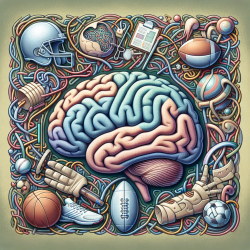The world of neurology is ever-evolving, and with it comes a deeper understanding of complex conditions like Chronic Traumatic Encephalopathy (CTE). A recent study titled "Unusual combinations of neurodegenerative pathologies with chronic traumatic encephalopathy (CTE) complicates clinical prediction of CTE" sheds light on the challenges faced by practitioners in diagnosing this condition. As a practitioner, understanding these complexities can significantly enhance your diagnostic skills and patient care strategies.
The Challenge of Diagnosing CTE
Chronic Traumatic Encephalopathy has gained significant attention due to its association with repeated head injuries, particularly in contact sports. Traditionally, CTE is diagnosed postmortem, making it challenging to link clinical symptoms directly to CTE pathology during a patient's lifetime. The study conducted by Taghdiri et al. highlights how the presence of copathologies further complicates this diagnosis.
The Study's Key Findings
- The research involved a retrospective case series of 12 former contact sports athletes who were referred for autopsy.
- All participants had a history of multiple concussions and exhibited progressive cognitive, psychiatric, or motor symptoms.
- The study found that 11 out of 12 participants had evidence of CTE in their brains alongside other neurodegenerative copathologies.
- The presence of diverse pathological combinations, including tauopathies and other rare entities, was noted.
Implications for Practitioners
This research underscores the importance of considering multiple potential pathologies when assessing patients with a history of repetitive head injuries. Here are some ways practitioners can apply these findings:
- Diversify Diagnostic Approaches: Given the heterogeneity of symptoms and copathologies, relying solely on presumptive CTE for diagnosis may be misleading. Consider comprehensive assessments that include evaluations for other neurodegenerative conditions.
- Encourage Further Research: The complexity revealed by this study highlights the need for continued research into the clinical manifestations and diagnostic criteria for CTE. Practitioners should stay informed about emerging studies and contribute to ongoing research efforts.
- Patient Education: Educate patients and families about the potential for mixed pathologies. Understanding that symptoms could arise from various conditions can help manage expectations and guide treatment plans.
A Call to Action
This study serves as a vital reminder that the landscape of neurodegenerative diseases is intricate and ever-changing. As practitioners, embracing this complexity through continuous learning and research is crucial for improving patient outcomes. To delve deeper into this topic and explore the original research paper, please follow this link: Unusual combinations of neurodegenerative pathologies with chronic traumatic encephalopathy (CTE) complicates clinical prediction of CTE.










